Rachel L. Carson
THE SEA AROUND US
To Henry Bryant Bigelow
who by precept and example has guided
all others in the exploration of the sea
Preface to the 1961 Edition
THE SEA HAS ALWAYS challenged the minds and imagination of men and even today it remains the last great frontier of Earth. It is a realm so vast and so difficult of access that with all our efforts we have explored only a small fraction of its area. Not even the mighty technological developments of this, the Atomic Age, have greatly changed this situation. The awakening of active interest in the exploration of the sea came during the Second World War, when it became clear that our knowledge of the ocean was dangerously inadequate. We had only the most rudimentary notions of the geography of that undersea world over which our ships sailed and through which submarines moved. We knew even less about the dynamics of the sea in motion, although the ability to predict the actions of tides and currents and waves might easily determine the success or failure of military undertakings. The practical need having been so clearly established, the governments of the United States and of other leading sea powers began to devote increasing effort to the scientific study of the sea. Instruments and equipment, most of which had been born of urgent necessity, gave oceanographers the means of tracing the contours of the ocean bottom, of studying the movements of deep waters, and even of sampling the sea floor itself.
These vastly accelerated studies soon began to show that many of the old conceptions of the sea were faulty, and by the mid-point of the century a new picture had begun to emerge. But it was still like a huge canvas on which the artist has indicated the general scheme of his grand design but on which large blank areas await the clarifying touch of his brush.
This was the state of our knowledge of the ocean world when The Sea Around Us was written in 1951. Since that time the filling in of many of the blank areas has proceeded and new discoveries have been made. In this second edition of the book I have described the most important of the new findings in a series of notes which will be found in the Appendix. [1] For this special edition of The Sea Around Us, Rachel Carson’s notes have been placed at the end of each corresponding chapter.
The 1950’s have comprised an exciting decade in the science of the sea. During this period a manned vehicle has descended to the deepest hole in the ocean floor. During the ’fifties, also, the crossing of the entire Arctic basin was accomplished by submarines traveling under the ice. Many new features of the unseen floor of the sea have been described, including new mountain ranges that now appear to be linked with others to form the longest and mightiest mountains of the earth—a continuous chain encircling the globe. Deep, hidden rivers in the sea, subsurface currents with the volume of a thousand Mississippis, have been found. During the International Geophysical Year, 60 ships from 40 nations, as well as hundreds of stations on islands and seacoasts, co-operated in an enormously fruitful study of the sea.
Yet the present achievements, exciting though they are, must be considered only a beginning to what is yet to be achieved by probing the vast depths of water that cover most of the surface of the earth. In 1959 a group of distinguished scientists comprising the Committee on Oceanography of the National Academy of Sciences declared that “Man’s knowledge of the oceans is meager indeed compared with their importance to him.” The Committee recommended at least a doubling of basic research on the sea by the United States in the 1960’s; anything less would, in its opinion, “jeopardize the position of oceanography in the United States” compared with other nations and “place us at a disadvantage in the future use of the resources of the sea.”
One of the most fascinating of the projects now planned for the future is an attempt to explore the interior of the earth by drilling a hole three or four miles deep in the bottom of the sea. This project, which is sponsored by the National Academy of Sciences, is designed to penetrate farther than instruments have ever before reached, to the boundary between the earth’s crust and its mantle. This boundary is known to geologists as the Mohorovicic discontinuity (or more familiarly as the Moho) because it was discovered by a Yugoslavian of that name in 1912. The Moho is the point at which earthquake waves show a marked change in velocity, indicating a transition from one kind of material to something quite different. It lies much deeper under the continents than under the oceans, so, in spite of the obvious difficulties of drilling in deep water, an ocean site offers most promise. Above the Moho lies the crust of the earth, composed of relatively light rocks, below it the mantle, a layer some 1800 miles thick enclosing the hot core of the earth. The composition of the crust is not fully known and the nature of the mantle can be deduced only by the most indirect methods. To penetrate these regions and bring back actual samples would therefore be an enormous step forward in understanding the nature of our earth, and would even advance our knowledge of the universe, since the deep structure of the earth may be assumed to be like that of other planets.
As we learn more about the sea through the combined studies of many specialists a new concept that is gradually taking form will almost certainly be strengthened. Even a decade or so ago it was the fashion to speak of the abyss as a place of eternal calm, its black recesses undisturbed by any movement of water more active than a slowly creeping current, a place isolated from the surface and from the very different world of the shallow sea. This picture is rapidly being replaced by one that shows the deep sea as a place of movement and change, an idea that is far more exciting and that possesses deep significance for some of the most pressing problems of our time.
In the new and more dynamic concept, the floor of the deep sea is shaped by racing turbidity currents or mud flows that pour down the slopes of the ocean basins at high speed; it is visited by submarine landslides and stirred by internal tides. The crests and ridges of some of the undersea mountains are swept bare of sediments by currents whose action, in the words of geologist Bruce Heezen, is comparable to “snow avalanches in the Alps (which) sweep down and smother the relief of the lower slopes.”
Far from being isolated from the continents and the shallow seas that surround them, the abyssal plains are now known to receive sediments from the margins of the continents. The effect of the turbidity currents, over the vast stretches of geologic time, is to fill the trenches and the hollows of the abyssal floor with sediment. This concept helps us understand certain hitherto puzzling occurrences. Why, for example, have deposits of sand—surely a product of coastal erosion and the grinding of surf—appeared on the mid-ocean floor? Why have sediments at the mouths of submarine canyons, where they communicate with the abyss, been found to contain such reminders of the land as bits of wood and leaves, and why are there sands containing nuts, twigs, and the bark of trees even farther out on the plains of the abyss? In the powerful downrush of sediment-laden currents, triggered by storms or floods or earthquakes, we now have a mechanism that accounts for these once mysterious facts.
Although the beginnings of our present concept of a dynamic sea go back perhaps several decades, it is only the superb instruments of the past ten years that have allowed us to glimpse the hidden movements of ocean waters. Now we suspect that all those dark regions between the surface and the bottom are stirred by currents. Even such mighty surface currents as the Gulf Stream are not quite what we supposed them to be. Instead of a broad and steadily flowing river of water, the Gulf Stream is now found to consist of narrow, racing tongues of warm water that curl back in swirls and eddies. And below the surface currents are others unlike them, running at their own speeds, in their own direction, with their own volume. And below these are still others. Photographs of the sea bottom taken at great depths formerly supposed to be eternally still show ripple marks, a sign that moving waters are sorting over sediments and carrying away the finer particles. Strong currents have denuded the crest of much of the vast range of undersea mountains known as the Atlantic Ridge, and every one of the sea mounts that has been photographed reveals the work of deep currents in ripple marks and scour marks.
Читать дальше












